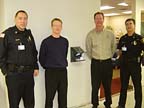Video for the Kids

Combined, the facilities use more than 100 cameras and are currently under major construction for expansion. The hospital had been recording camera feeds to a tape-based system that had been discontinued, and wanted to expand into networked digital recording.
Image quality
They turned to Alex Pavlis at Henry Brothers Electronics for the solution. Located in the city of Orange, Calif., CHOC and its sister hospital have had their extensive security needs serviced by Pavlis’ company for years. He, in turn, specified a DVR from Mitsubishi Digital Electronics America Inc., located in nearby Irvine, Calif.“We selected the DX-TL5000U because it was a high end system with superb video quality that was easy to operate,” said Pavlis. “The intuitive digital functions and easy software allow simple interface so operators can use it in an analog fashion while maintaining the high quality digital recording and features.”
Such appreciation for innovation in technology has historically been a primary feature of the CHOC.
It was the first children’s hospital in Orange County; the first to open an emergency room for children; the first to complete a pulmonary resection in a child using a robotic system; the first in the nation to use the LICOX, a brain oxygen monitor, in young children with traumatic brain injuries; the first in the nation to conduct a balloon dilation of a cardiac lesion, now a routine cardiac procedure; the first to use an Amplatzer device; and even the first to perform fetal MRIs. The list doesn’t end there.
Pavlis was particularly interested in the young system’s ability to network DVRs through the security nerve center and to set picture resolution. He noted that one of the problems some current DVRs present to security operations is that they permit only one slow record speed or one global setting for recording across all inputs.
The system, now installed at the hospital, offers speeds of 960 pictures per second for live images and 240 PPS for recorded images. It also permits each of the 16 video inputs to be set individually for the most efficient allocation of resources and the highest quality imaging at their central security station in Orange, which also handles all alarms, surveillance and access control.
Integrator Henry Bros Electronics is a subsidiary of Diversified Security Solutions, with offices in Fullerton, Calif.; Phoenix; Saddle Brook, N.J.; and Grand Prairie, Texas. It provides technology-based integrated electronic security systems, services and emergency preparedness consultation.
Sidebar: Hospital Prescribes Biometrics
Aspirus Wausau Hospital of Wausau, Wisc., recently deployed 50 biometric HandReaders from Recognition Systems, a unit of Ingersoll Rand, Campbell, Calif., at key entry and exit points. Over 3,000 Aspirus Wausau employees are enrolled with the readers, which automatically take a three-dimensional reading of the size and shape of a hand and verify the user’s identity in less than one second.“We chose biometrics because of the high cost of using access control cards,” said Greg Pehlke, security supervisor for the hospital. “We were spending $2,000 a month on smart cards with computer chips, which employees were simply loaning to unauthorized individuals. Much of this cost, and the security breaches, have been eliminated.” The hospital’s 50 readers include outdoor models to handle Wisconsin weather.
Looking for a reprint of this article?
From high-res PDFs to custom plaques, order your copy today!





